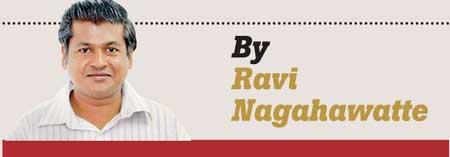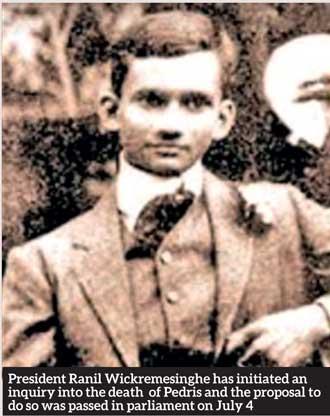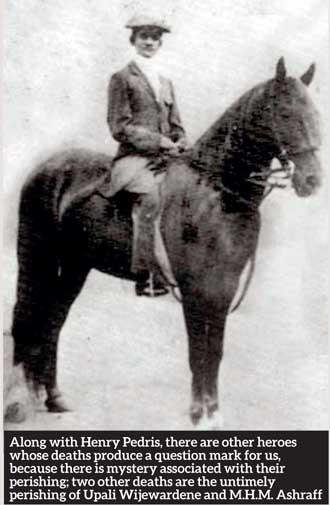06 Jul 2024 - {{hitsCtrl.values.hits}}
 At a time when Sri Lanka is in search of a national hero and other powerful nations are trying to spread their ambitious nets here in this country, the islanders get an opportunity to remember a stalwart who pioneered the rebellion against the British.
At a time when Sri Lanka is in search of a national hero and other powerful nations are trying to spread their ambitious nets here in this country, the islanders get an opportunity to remember a stalwart who pioneered the rebellion against the British.
This hero is none other than Deinge Edward Henry Pedris whose 109th commemoration is set to take place at 4:30pm on July 7 (Sunday) at Havelock Town in Colombo near the Henry Pedris Statue. The organising of the event is done by Edward Henry Pedris Commemoration Society as in past years.
Hundred and eight years of commemorating a man of this calibre and going on to the 109th year has drawn attraction for another reason as well. The government of Sri Lanka under  President Ranil Wickremesinghe has initiated an inquiry into the death of Pedris and the proposal to do so was passed in parliament on July 4. The proposal was made by the President himself.
President Ranil Wickremesinghe has initiated an inquiry into the death of Pedris and the proposal to do so was passed in parliament on July 4. The proposal was made by the President himself.
Sri Lanka lost many of its heroes to the rebellions against the British. Pedris was executed by the British for treason, but charges against him weren’t proven. This could be the reason for the government’s decision to probe the killing of an ‘officer and a gentleman’. He served the Colombo Town Guard as a Private and quickly rose to the rank of Captain. In his personal life, he was a teetotaler and an active member of the Colombo Society. He was just 26 years old at the time of his death.
Literature on his death reveals that the British suspected him of being engaged in acts of treason. He was strapped on to a chair and ordered to be shot dead. He requested that his life be taken away by the bullet of a member of the Panjabi Firing Squad and not by a member of the British Firing Squad. The British relented to his request. When the time came for the execution Pedris pulled out his own handkerchief and gave it to the British to blindfold him. Literature about Pedris reveals that more than one bullet was needed to complete the execution.
The death of Pedris was meant to send a clear message to Sri Lanka prisoners: this would be the fate of all who rebelled against the British. But Pedris’ execution also sowed the seeds of liberty. F.R. Senanayake, who was also in person at that time, vowed to stand up against the British. Pedris’ death hastened Ceylon’s movement for independence from the British. Pedris was executed on July 7, 1915. Ceylon received Independence on February 4, 1948.
Pedris’ father – D. D. Pedris-was shaken and broken by the death of his son. But he chose to be silent about the bereavement in the family fearing more harm to the rest of the family by the British rulers. Sri Lankan citizens of yonder were educated and wise enough to understand, when to take a step back during an incident to avoid more disaster from taking place.
D.D. Pedris made the Isipathana Temple, situated in Havelock Town, in memory of his late son; and on to make a pilgrim’s rest in Polonnaruwa; also in the remembrance of his deceased  son. In later years, when Ranasinghe Premadasa was prime minister of this country, a statue was unveiled on July 7, 1987, in Havelock Town in the name of Henry Pedris. On the same day a stadium in the close proximity of the statue was named as ‘Henry Pedris Stadium’. Many of the most memorable rugby matches witnessed on this island have been played on this venue. The management of this stadium was recently handed over to Isipathana College, one of the most prominent rugby playing schools in Colombo which was till then struggling to arrange practice sessions due to being handicapped without a proper rugby ground.
son. In later years, when Ranasinghe Premadasa was prime minister of this country, a statue was unveiled on July 7, 1987, in Havelock Town in the name of Henry Pedris. On the same day a stadium in the close proximity of the statue was named as ‘Henry Pedris Stadium’. Many of the most memorable rugby matches witnessed on this island have been played on this venue. The management of this stadium was recently handed over to Isipathana College, one of the most prominent rugby playing schools in Colombo which was till then struggling to arrange practice sessions due to being handicapped without a proper rugby ground.
The name Henry Pedris has surfaced on and off in Sri Lanka. In 1978, Dr. H.N.S. Karunathilake penned a book in his name titled ‘The life and times of National Hero, Edward Henry Pedris’. In 1971 a stamp was issued in his name. But the biggest tribute that can be paid to this man is to open up an investigation into his death. Critics believe so because Henry Pedris was not executed following the existing laws of the country. His death was facilitated by the Army Act. Hence the family was not given an opportunity to conduct final rites on behalf of a son who perished prematurely and whose remains were disposed of hurriedly. This writer recalls an old saying that is owned by author Ernest Hemingway which goes ‘A man can be destroyed, but not defeated’. Hemingway says that the dictum he penned is a double dicho; which means the saying can be said the other way around as well. The above saying can be attributed to Henry Pedris.
We can still relate to Henry Pedris and see his statue each day when we pass Havelock Town. But like Henry Pedris, there are so many other heroes whose deaths still produce a question mark for us because there is mystery associated with their perishing. Two other deaths that come to this writer’s mind at this juncture are the untimely perishing of Upali Wijewardene and M.H.M. Ashraff. Those two deaths also demanded much investigation by their loved ones. Henry Pedris, like Wijewardene and Ashraff, was earmarked to be a great product of this country, but fate cut short a career well begun.
The government initiated investigation into the killing of Henry Pedris will be spearheaded by a three-member committee chaired by Supreme Court Judge Justice Anil Gunaratne.
This investigation would be a case in study for law students. For a nation it would be an attempt at trying to rectify an occasion where justice was denied. Till then let’s say a prayer in memory of this great national hero!
|
In 1971 a stamp was issued in his name |
23 Nov 2024 8 hours ago
23 Nov 2024 8 hours ago
23 Nov 2024 23 Nov 2024
23 Nov 2024 23 Nov 2024
23 Nov 2024 23 Nov 2024